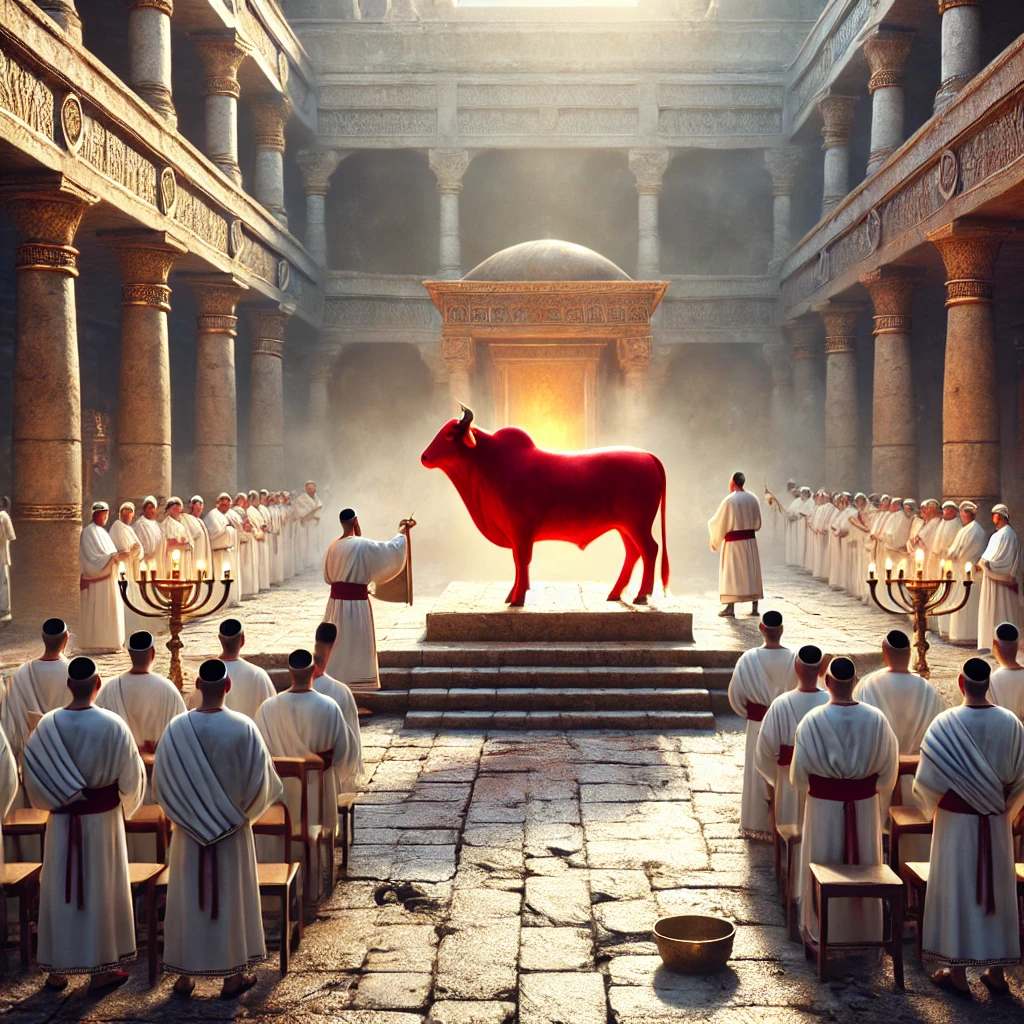Red Heifer Ritual: A 2,000-Year-Old Prophecy

In recent years, the red heifer ritual—an ancient biblical commandment—has remained largely unknown to the general public, despite ongoing efforts by religious groups to prepare for its revival. In September 2022, five unblemished red heifers were transported from the United States to Israel, an event that many within certain religious communities saw as a significant step toward reinstating a ritual that has not been performed in nearly 2,000 years. As of early 2025, these heifers have reached the requisite age for the ceremony, leading to speculation that the event could take place soon. While the wider public remains unaware, scholars, religious leaders, and prophecy watchers see this as a moment of profound spiritual and historical significance, with some believing that its completion could usher in a new era in Jewish worship and potentially fulfill biblical prophecy regarding the Messianic age and the rebuilding of the Third Temple. The red heifer ritual enables ritual purification, allowing the Third Temple to be built and become fully operational. Once established, it would restore ancient temple worship, sacrificial offerings, and priestly duties, fulfilling prophecy and ushering in a new spiritual era.
Described in the Book of Numbers (19:1–22), a section of the Hebrew Bible (Tanakh) and the Christian Old Testament, the sacrifice of a flawless red heifer was necessary for the purification of those who had come into contact with the dead, making it a pivotal element of ancient Jewish temple practices. In these verses, God commands Moses and Aaron to instruct the Israelites on the detailed procedure for purification. The heifer was to be completely red, without defect or blemish, and never to have been yoked. It was to be taken outside the camp and slaughtered before the priest, who would then sprinkle its blood seven times toward the front of the Tabernacle. The entire heifer, including its hide, flesh, blood, and dung, was then burned, and the ashes were collected and mixed with water to create a purification solution. Cedarwood, hyssop, and scarlet wool were also added to the burning process, symbolizing spiritual cleansing. This water of purification was then used to cleanse individuals who had become ritually impure due to contact with a corpse.
Rituals played a fundamental role throughout the Bible, shaping the spiritual and communal life of the Israelites. The Torah outlines numerous sacrificial and purification ceremonies, many of which were carried out in the Tabernacle and later in the Temple. Among the most notable are the burnt offerings, sin offerings, and peace offerings described in Leviticus, each serving distinct purposes in maintaining holiness and atoning for sins. The Day of Atonement (Yom Kippur) included elaborate rites where the high priest would enter the Holy of Holies, offering sacrifices and symbolically transferring the sins of the people onto a scapegoat. The Passover sacrifice, another deeply significant ritual, commemorated the Israelites’ deliverance from Egypt and required the slaughter of an unblemished lamb. These rituals reinforced the connection between the Israelites and God, emphasizing obedience, repentance, and divine favor.
According to Jewish tradition, only nine such heifers were ever sacrificed before the destruction of the Second Temple in 70 CE. Since then, the ritual has not been performed, leading many to believe that the appearance of a tenth red heifer would signal the approach of the Messianic era and the eventual rebuilding of the Third Temple.
The destruction of the Second Temple marked a turning point in Jewish history, ending the sacrificial practices that had defined the religion’s connection to the divine for centuries. Without a Temple, the red heifer purification ceremony became impossible to perform, rendering all Jews in a state of ritual impurity according to biblical law. However, prophecy suggests that the ritual will be restored in the future, and with it, a renewal of divine presence in Jerusalem.
The rebuilding of the Third Temple would carry profound significance for humanity. For the Jewish people, it would mark the restoration of ancient worship practices and a fulfillment of divine prophecy, creating a direct and renewed connection between God and His people. Many believe it would usher in a new era of spiritual enlightenment and peace, as foretold in biblical prophecies. For Christians who see the Temple’s reconstruction as a key part of end-times prophecies, its re-establishment could signify the unfolding of apocalyptic events leading to the return of Christ. At the same time, for the broader world, the building of the Third Temple would likely introduce new geopolitical and religious tensions, particularly given the sacred nature of the Temple Mount, which is also revered in Islam. Whether viewed as a divine mandate, a historical restoration, or a catalyst for global conflict, the realization of the Third Temple’s construction would undeniably mark a transformative moment in human history, shaping spiritual perspectives and influencing world affairs in profound ways.
Modern developments have reignited speculation about the fulfillment of this prophecy. These heifers have been carefully monitored to ensure they meet the strict biblical requirements: completely red, unblemished, and never having borne a yoke. As of early 2025, these heifers have reached the appropriate age for sacrifice, prompting discussion about when and where the ritual might take place.
Adding to the complexity of prophetic discussions, Ezekiel’s visions in the Hebrew Bible have long been associated with both the Third Temple and mystical interpretations of divine encounters. Ezekiel 40–48 describes a future temple with detailed architectural features, which some believe to be a blueprint for the anticipated Third Temple. Meanwhile, Ezekiel 1 presents a striking vision of a “wheel within a wheel” accompanied by living creatures, imagery that has been interpreted in various ways. Traditional Jewish and Christian scholars regard this as a depiction of the majesty and omnipresence of God, while some ancient astronaut theorists propose that it could describe an encounter with advanced NHI technology. In his book The Spaceships of Ezekiel, former NASA engineer Josef F. Blumrich analyzed Ezekiel’s descriptions and suggested they might refer to a spacecraft. Regardless of the interpretation, Ezekiel’s visions remain a central point of discussion for those studying biblical prophecy and its potential modern implications.
Despite its deep religious significance, the reintroduction of the red heifer ritual also raises political and theological tensions. The Temple Mount, located in Jerusalem’s Old City, is one of the most sacred and contested religious sites in the world. Revered by Jews, Christians, and Muslims, it is traditionally believed to be the location of the First and Second Temples. The First Temple, built by Solomon, was destroyed in 587/586 BCE, and the Second Temple was demolished by the Romans in 70 CE. Today, the site houses the Dome of the Rock and Al-Aqsa Mosque, making any discussion of rebuilding a Third Temple highly sensitive. Those advocating for the Third Temple believe it must be constructed on or near this historic site, while geopolitical and religious tensions complicate any movement toward that goal. Nonetheless, for those who view the ritual as a necessary step in the fulfillment of prophecy, such concerns are secondary to what they perceive as the unfolding of a divine plan. The location of the ritual, particularly if it is conducted near the Temple Mount, could spark controversy due to the sacred and contested nature of the site. Nonetheless, for those who view the ritual as a necessary step in the fulfillment of prophecy, such concerns are secondary to what they perceive as the unfolding of a divine plan.
The red heifer ritual, a practice that has not been performed in nearly 2,000 years, is now the focus of renewed efforts aimed at its revival. Whether or not the anticipated sacrifice takes place in the coming months or years, its growing prominence signals a rising expectation that long-standing prophecies are moving toward fulfillment. For those who watch the signs, the reappearance of the red heifer is not just an ancient ritual—it is a harbinger of profound spiritual change.


